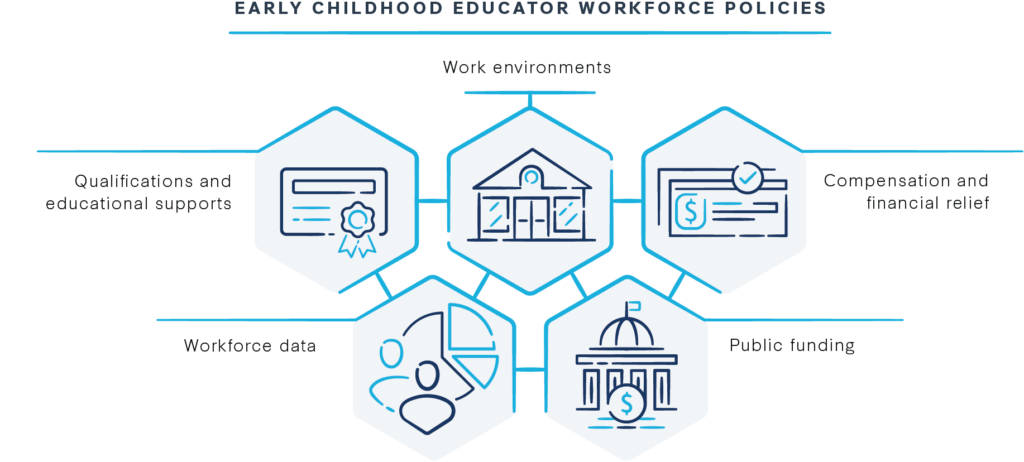Taking Action: Using the Early Childhood Workforce Index
We need policy action to solve the child care crisis for early educators and the children and families that rely on them.
The current system and financing of early care and education (ECE) pose severe risks to educators’ well-being, reinforce disparities in earnings and opportunities among educators, and hinder efforts of all educators to equitably facilitate children’s learning.
This resource is a companion to the 2024 Early Childhood Workforce Index to channel its research into policy action. The toolkit is created for:
- Early educators
- Policymakers
- State administrators
- Public and private funders
- ECE policy advocates
- Allies passionate about strengthening the ECE workforce
About CSCCE
Our vision is to create an equitable, effective, and universal publicly funded early care and education system that secures racial, gender, and economic justice for the educators whose labor is the linchpin of stable, quality services.
We ground our work in a foundation of shared values, employing five guiding principles for reform to define the process and assess impact of our work as well as those reforms and proposals put forth by others. We understand these principles as matters of social justice and requisite for truly achieving our vision. Our vision and principles for reform come together to articulate a theory of change that fuels our actions as a research and policy partner.
CSCCE’s Theory of Change
Our Theory of Change is informed by our values and guiding principles to create an equitable, effective, and universal publicly funded early care and education system.
Let’s Get Started: Take Action Using the Early Childhood Workforce Index
Poor working conditions in early care and education are not inevitable, but a product of policy choices.
Policy change occurs when collective action is coordinated among early educators, policymakers, state administrators, public and private funders, advocates, and allies passionate about strengthening the ECE workforce (e.g., parents and families).
Collective action by early educators and advocates has been essential whenever progress has been made toward a more just ECE system. Explore the historical pillars of activism in the early childhood workforce by visiting the Early Childhood Historical, Organizing, Ethos, and Strategy (ECHOES) Project.
Messages and findings from the Early Childhood Workforce Index can be cited to drive policy change that centers the experiences of early educators. After all, an ECE system that provides equitable, accessible, and quality care for children and families is only possible with a robust and qualified workforce that is well compensated for their professional expertise and incentivized to advance in the ECE field.
“I’m learning more about the Workforce Index—knowing it exists and that it can be shared with other educators so they can advocate for themselves. It’s great to know what other states are doing. It’s okay to reach out to our state legislators to advocate for ourselves.”
Early Childhood Educator
There is no single ingredient to reform. To achieve the vision we seek, we must take action across a set of interconnected avenues for change. The Index is organized around five essential areas of policy to support early educators.
Five Essential Workforce Policy Areas
- Qualifications and educational supports: Policies and pathways that provide consistent standards and support for educators to achieve higher education.
- Work environment standards: Standards and funding to make sure ECE programs can provide safe and supportive work environments for early educators.
- Compensation and financial relief: Initiatives and investments to ensure compensation is commensurate with that of a skilled professional, accounting for the educator’s qualifications, expertise, and experience.
- Workforce data: State-level collection and use of key data on the size, characteristics, and working conditions of the ECE workforce.
- Public funding: Public investment in the ECE workforce and broader ECE system.
For an additional list of terms and definitions related to the ECE workforce, visit the Index Glossary of Terms.
For each of the five interconnected elements, our policy opportunities present a pathway to making headway for the early childhood workforce.


Qualifications & Educational Supports
Vision
All early educators working with children age birth to five have access to support and resources to acquire foundational knowledge and pursue ongoing learning.
Policy Opportunities for Change
- Design equitable credential systems and align qualification requirements across settings.
- Establish minimum requirements that reflect foundational knowledge (i.e., a Child Development Associate Credential or equivalent) for all early childhood teaching staff.
- Establish a bachelor’s degree with early childhood education specialization and individual licensure or certification for lead teachers and program leaders, in line with what is required for teachers of older children.
- If these conditions are not met or publicly funded, neither individuals nor programs should be penalized for failing to meet qualifications that are only recommended and not required.
- As new qualification requirements are implemented, develop an intentional strategy to provide dual support to the incoming workforce while also supporting the existing workforce to meet requirements. Effective policy strategies include valuing and accounting for years of experience and providing financial support and a flexible work schedule to acquire additional education, training, or certification within a reasonable timeline.
- Ensure that all members of the current and future workforce have opportunities and support to acquire education and training at no personal financial cost.
- Partner with educators to identify pathways and conditions that reflect their aspirations and needs.
- Identify systemic barriers and develop equity-driven solutions to facilitate access and create the conditions for educators to successfully advance.
- Design and fund specific strategies to facilitate the attainment of associate and bachelor’s degrees among historically oppressed racial and ethnic groups as well as individuals who speak English as a second language.
- Regularly collect and review data about scholarship programs and other educational initiatives to identify disparities in access and to assess whether such programs are providing adequate levels of support.
- Learn more about national recommendations to transform the ECE workforce by referring to the Institute of Medicine and National Research Council report Transforming the Workforce for Children Birth Through Age 8: A Unifying Foundation.
Tools: Scholarships, apprenticeships, professional pathways counseling, transferable credits for experience, comprehensive articulation agreements.
Framing the Issue
- As Early Educators: “As early educators, we shape children’s lifelong learning. It’s complex work. With resources like scholarships and programs designed for us as working adults, we’re able to continually advance our own knowledge and skills to improve our practice with children.”
- As Policy Advocates: “In our state, the qualifications a child’s teacher is expected to meet depend more on what the family can afford and the types of programs available in their area than on the child’s developmental and educational needs.”
- In Relation to COVID-19: “Pandemic relief funding helped address the shortage of early educators by investing in education and training programs. The funds attracted early educators into the field and retained existing educators to build a strong, well-prepared workforce.”
In Action
New Mexico developed an aligned curriculum with articulation across the higher education system, along with a scholarship and wage supplement program for early educators.


Work Environment Standards
Vision
All early educators flourish in well-resourced work environments that prioritize teaching supports, a robust learning community to develop teaching practice, educator agency and autonomy, and comprehensive policies that promote economic, emotional, physical, and professional well-being. All early childhood program leaders are supported and trained to be inclusive, responsive, and supportive.
Policy Opportunities for Change
- Advance the emotional and physical health and well-being of educators in the work environment by ensuring appropriate compensation and access to health care, including mental health supports.
- Adopt system-level workplace standards, such as guidance on appropriate levels of paid planning time. Paid planning time is necessary for educators to engage in professional practice to support children’s learning and to alleviate conditions that cause educator stress.
- Use existing models, such as the International Labor Organization Policy Guidelines and the U.S.-based Model Work Standards for Centers and Homes.
- Develop intentional mechanisms to engage educators as partners in the process of developing workplace standards to ensure these standards reflect their needs and experiences.
- In partnership with educators, assess and update quality, licensing, and competency requirements to include workplace standards, with the goal of implementing equitable standards across programs.
- Recognize and remedy the racial and class inequities embedded in QRIS by providing sufficient public funding for all programs to meet work environment standards.
- Provide ongoing financial resources and technical assistance to enable programs to implement standards in a reasonable period of time and to sustain compliance with these standards over time.
- Require all programs that receive public funding to complete training on work environment standards and to implement an annual self-assessment and improvement plan.
- Collect data on a regular basis from early educators to assess how they experience the standards in their work environments and communicate how changes will be made to address their feedback and concerns.
- Establish the right of all early educators to organize and/or join a union. Unions provide a safe channel to report and remedy unsafe or problem conditions in the work environment.
- Ensure protections are in place for workers who report workplace or regulatory violations (e.g., California’s whistleblowing law). As part of onboarding and annual protocols, inform educators about their rights, including state laws around occupational health and safety, and the reporting process.
Tools: Paid planning time, paid professional development, substitute pools, SEQUAL Survey, International Labor Organization Policy Guidelines, Model Work Standards for Centers and Homes.
Framing the Issue
- As Early Educators: “Paid time off to prepare would support my aspirations as a teacher. Instead, I am doing most of my planning unpaid at night and on weekends, which takes a toll on my well-being.”
- As Policy Advocates: “Teachers in the K-12 system can typically expect their jobs to include policies and resources that support teacher well-being and development. In contrast, most early educators are not able to rely on dependable breaks, substitutes, or paid time to plan and confer with other teachers.”
- In Relation to COVID-19: “Educators need to feel safe and protected from health and safety concerns to be fully present with children. There is a need to strengthen workplace emergency preparedness to ensure the future health and safety of educators, children, and families.”
In Action
QUALITYstarsNY is New York’s QRIS and one of the few systems that has a built-in provision of paid planning or preparation time as part of its “Management and Leadership” standards category for center- and home-based providers.

Compensation & Financial Relief Strategies
Vision
All early educators are equitably compensated with professional pay and receive standard benefits, including paid time off, health insurance, and retirement.
Policy Opportunities for Change
- Establish, implement, and fund wage standards that ensure, at a minimum:
- All ECE workers earn at least a locally assessed living wage;
- Early educators with similar levels of education and/or experience are paid no less than parity with elementary school teachers;
- Wage/salary increments are clearly differentiated based on role, qualifications, years of experience, and forecast wage/salary increases over time;
- Regular adjustments are made for cost of living and inflation;
- Home-based family child care providers are able to pay themselves and any assistants a salary that meets equivalent wage standards to their center-based peers; and
- Pay inequities, such as racial wage gaps or lower pay for infant and toddler teachers, are identified and remedied.
- Establish and fund benefit standards, incorporating at minimum:
- Guaranteed paid time off (this includes paid sick days, vacation, and parental leave);
- Enrollment in comprehensive health insurance plans at no cost or a significantly reduced cost to the educator;
- Funding for retirement plans that provide federal and/or state contributions to educators with a vesting schedule that allows educators to retire with economic dignity; and
- For enrollment in programs like child care subsidies or healthcare initiatives that require low wage thresholds for eligibility, consider creating an income waiver or establishing educators as a priority population.
- Dedicate sufficient public funding for all programs to meet wage and benefit standards.
- Design accountability measures to verify that wage and benefit standards are applied to educator compensation.
- Partner with educators to routinely assess immediate and long-term needs associated with the implementation and sustainability of wage and benefit standards.
- Frame advocacy messages to clarify that financial relief initiatives (tax credits, stipends) are an interim strategy, not a long-term solution that will increase paychecks and benefits for early educators.
Tools: Salary scales, wage supplements (tax credits, bonuses, stipends), retirement saving accounts, public benefit enrollment assistance (e.g., Affordable Care Act health care).
Framing the Issue
- As Early Educators: “I have a higher education degree, plus additional certifications and many years of teaching experience—the same or even more than a 2nd grade teacher. Why should I be paid any less?”
- As Policy Advocates: “Our state’s ECE workforce is qualified, experienced, multilingual, and multicultural, with a demonstrated commitment to our youngest learners. However, poor compensation undermines our efforts to attract and retain a skilled and stable workforce. While some progress has been made, we have not yet been able to fundamentally improve the low earnings of the teachers of our youngest children, leaving many unable to support themselves and their families.”
- In Relation to COVID-19: “Federal relief funding gave many programs the ability to increase wages or provide bonuses for their staff. We need permanent, sustained funding to ensure educators are paid appropriately and that a career in early childhood is attractive and sustainable.”
In Action
In California, the child care union contract negotiated by Child Care Providers United (CCPU) established an $80-million annual investment in a newly established retirement fund for FCC providers—the only one in the nation.
“We have relied heavily on CSCCE’s Workforce Index as we worked with legislators to introduce wage supplement pilots two years in a row. The data from a well-regarded, independent institution like CSCCE lent us credibility that the problem of early educator retention existed long before the COVID-19 pandemic began.”
Hawaiʻi Children’s Action Network

Workforce Data
Vision
All states collect and report up-to-date, comprehensive ECE workforce information that is transparent and used to design and implement professional development pathways and delivery of workforce supports.
Policy Opportunities for Change
- Maintain an active workforce registry that requires and facilitates participation from all members of the licensed and/or registered ECE workforce, including FCC providers.
- Conduct periodic surveys and/or focus groups to assess the state of the ECE workforce. Determine a cadence for collecting new data, for instance, every three to five years.
- If your state does not have a robust registry or data system strategy, ensure your survey gathers demographics (age, race and ethnicity, language) and compensation (wages, health coverage, retirement savings).
- If your state or region already has a comprehensive registry or data system, pivot to topic-driven surveys that respond to policy questions (e.g., current levels of turnover). Meanwhile, your data system can provide core details like demographics.
- Ensure that data systems support analysis and reporting and are used to:
- Assess the impact of policy and funding decisions on early educators;
- Inform local, state, and national ECE reform efforts in a timely manner; and
- Build in regular assessment processes to uncover and address disparities in such areas as compensation, educational attainment, job advancement, and tenure according to variables such as race and ethnicity, age, and geography.
- Support the integration of workforce data with broader early childhood data systems and governance, such as licensing databases, resource and referral databases, QRIS, early childhood health data, and K-12 data.
- Streamline data systems to minimize the burden on early educators.
- Make data available to early educators to promote access and transparency.
- Dedicate ongoing funding to stewarding high-quality data, including adequate staffing and data infrastructure for workforce data collection, management, and analysis.
- For example, prioritize workforce data system development and improvement in state Child Care Development Fund (CCDF) plans and other state and federally funded plans.
- Join with other state leaders to encourage federal leaders to:
- Establish common terms and standardized input fields to be used across datasets to ensure comparability;
- Improve federally funded datasets that include data on early educators to address existing shortfalls; and
- Include early educators in decision-making discussions about how to ensure data are useful for educators as well as policymakers.
Tools: Workforce registry, workforce survey.

Framing the Issue
- As Early Educators: “It’s important for parents and the public to know what our working conditions are like and the detrimental effects on our own well-being and on the well-being of the children in our care.”
- As Policy Advocates: “Improving the status of our early educator workforce rests on our ability to describe basic demographic, education, and employment characteristics. Currently, we collect only limited data on the workforce and only for those in certain settings or funded programs. This makes it challenging to understand the reach and effectiveness of current policies or to answer questions like: ‘How prepared is the current workforce to provide effective care and education for all children in our state?’”
- In Relation to COVID-19: “During the pandemic, having a workforce registry was critical to connecting educators on the ground with emergency funding to keep programs open and to direct resources where most needed.”
In Action
In Wisconsin, the WECA Shared Services Network encourages their members who are FCC providers to join the registry by covering costs and assisting with sign-up, and thus plays a key role in collecting information on these home-based educators and connecting them with financial relief paid through the registry.

Public Funding
Vision
All states, territories, and Tribes have sufficient, equitable, and sustainable public funding to prepare, support, and compensate the ECE workforce across all settings.
Policy Opportunities for Change
- Identify the public funding needed to attract and retain qualified early educators and ensure equitable ECE access for all children and families.
- Stop using market-based approaches to child care (i.e., prices determined by what families can afford to pay). Instead, use a Cost Estimation Model to gauge the true costs of advancing workforce preparation, increasing workforce compensation supported by a salary scale, and improving working conditions, while also relieving the financial burden on families.
- Through a Cost Estimation Model, states can identify the additional public funding required to close the gap between existing public funds and the true costs to accomplish necessary reforms. To understand the landscape of existing public funds, consider creating a fiscal map.
- At a minimum, working within the subsidy system, states can switch to an alternate methodology for determining CCDF rates (as per Housing and Human Services recommendations) that includes accurate cost estimates to increase compensation and retain a high-quality workforce. However, subsidy reimbursement is just one funding mechanism and does not reach all child care programs.
- Commit to securing dedicated, sustainable funds to realize comprehensive reforms.
- Policymakers can prioritize early care and education in state budgets in addition to (or in the absence of) increased federal funding.
- Advocates can launch campaigns to inform policymakers and help educate the public about the costs of building an equitable system and the benefits of this investment as a public good.
- Engage voters to activate reforms by proposing ballot measures that set up dedicated sources of revenue to fund early care and education locally and throughout the state.
- Use data as evidence to show that the additional public funding made available through pandemic relief funds helped stabilize the ECE system and workforce.
- Design and activate a phased implementation plan to equitably allocate new and existing funds to establish an ECE system that operates as a public good.
- Build in annual fund adjustments to adjust for inflation, cost of living increases, and changes to regulations (e.g., minimum wage increases) and/or licensing and quality standards.
- Consult providers to ensure that implementation plans are designed to advance equity and remedy existing disparities, while also aligning with the providers’ immediate and long-term needs.
- Partner with providers to develop feedback loops that inform and improve implementation through ongoing engagement, data collection, and analysis.
- Explore opportunities to invest directly in ECE programs using grants and contracts, learning from the implementation of American Rescue Plan Act (ARPA) stabilization grants.
Tools: Cost estimation models, CCDF alternate methodology/cost-informed child care subsidy reimbursement rates, federal grants (e.g., PDG B-5), fiscal mapping, state and local dedicated funds.
Framing the Issue
- As Early Educators: “For a long time, early childhood education has operated as a broken market, with reliance on what parents can afford to pay and educators struggling to make ends meet on poverty-level wages. Parents can’t afford to pay more. We must have sufficient and equitable public funding to cover our costs and compensate educators as professionals.”
- As Policy Advocates: “Multiple and complex funding streams that supply inadequate funding can make it challenging to develop financial strategies to improve conditions across ECE settings. If we want to ensure that every child in our state has the opportunity to thrive, it is critical that we strategize on how to finance equitable access to affordable, high-quality early care and education.”
- In Relation to COVID-19: “Federal funding through the American Rescue Plan and other pandemic relief packages helped to shore up early care and education but child care needed support long before COVID. The increase in federal funding during COVID provided a proof point that public funds can be effectively used to invest in the workforce and stabilize early care and education. Child care is a part of our social and economic infrastructure, we need to invest accordingly.”
In Action
Vermont passed a payroll tax to increase investments in early care and education. This sustainable source of revenue provides funding to raise provider subsidy rates based on the true cost of care.
Is your state making progress? Check your state’s 2024 Early Childhood Workforce Index profile or view the State Explorer.



